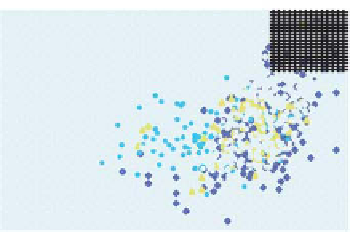Geology Reference
In-Depth Information
2
1
0
−
1
−
2
Skeletal
material
−
3
4
−
1
0
1
2
3
4
5
6
−
13
C (‰)
δ
18
O of sediments based on data shown in Figs 5 and 6 (region
enclosed by cross-hatched symbol), compared with the mean
13
C and
Fig. 11.
Ranges of equilibrium estimates of
18
O values measured on carbonates in this study
(area enclosed by blue rectangular area). Carbonate data are the same as shown in Fig. 2. Estimates for skeletal data (red
rectangular area) are taken from the literature (Weber, 1965; Milliman, 1974; Swart, 1983; Land, 1989).
13
C and
fractionation of the DIC during photosynthesis
and the natural enrichment of aragonite relative
to LMC (see above). These sediments are exported
from the platform and form periplatform sedi-
ments (Schlager & Ginsburg, 1981; Eberli
et al.,
1997; Eberli, 2000) that drape the fl anks of the
platform and extend into the pelagic realm. It has
been shown that the
platforms in previous geological time periods.
For example, it has been proposed that the
normal form of calcium carbonate precipitated
from marine seawater has changed through-
out geological time as a function of the Mg/Ca
ratio of the oceans varying between 'calcite' and
'aragonite' seas (Sandberg, 1983; Hardie, 2003;
Lowenstein
et al.,
2003). During periods of
'calcite' seas, clearly the
13
C of such sediments can
be correlated between units of equivalent age, but
that these
13
C of carbonates
formed on the platform would probably not be
as isotopically positive today because the only
mechanisms that would enrich the platform
carbonates would be the infl uences of photosyn-
thesis and fractionation during the precipitation
of calcium carbonate. The platform-derived car-
bonate would nevertheless be more isotopically
positive than pelagic material formed at the same
time, although not as enriched that as today. Hence
it is proposed that there still might be a carbon
isotopic effect as a result of precipitation on
carbonate platforms during periods of 'calcite'
seas, but that this might be reduced compared
with periods of 'aragonite' seas.
13
C values are not related to pelagic
13
C values (Swart & Eberli, 2005). The reason
for the correlation between units of similar age
arises as varying amounts of surface sediments
enriched in
13
C, mix with more depleted carbon-
ate derived from pelagic sources. As all sediment
size fractions have similar
13
C values, the mix-
ing does not appear to change as a function of dis-
tance from the platform. This pattern may not be
present surrounding carbonate buildups with high
percentages of aragonite derived from calcareous
organisms such as corals.
The question posed by this study is whether
the results are at all applicable to carbonate




















































































